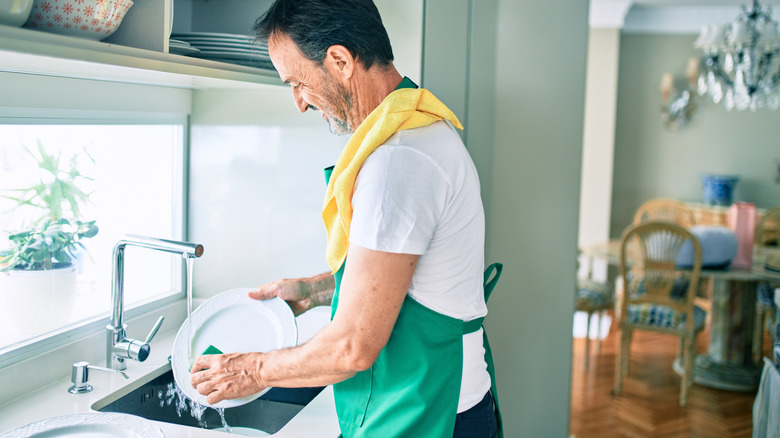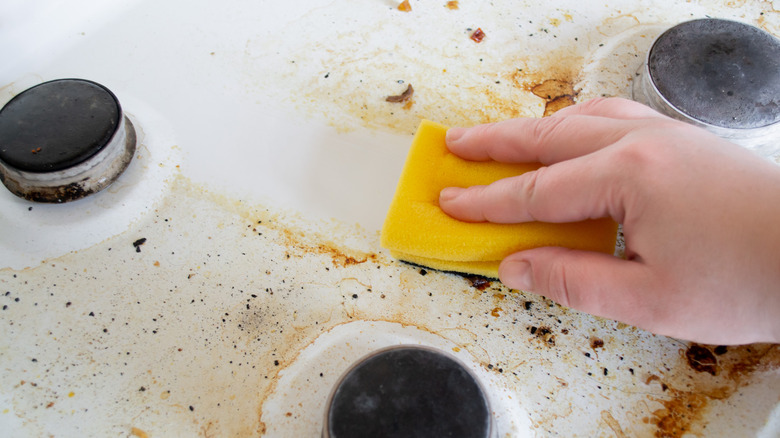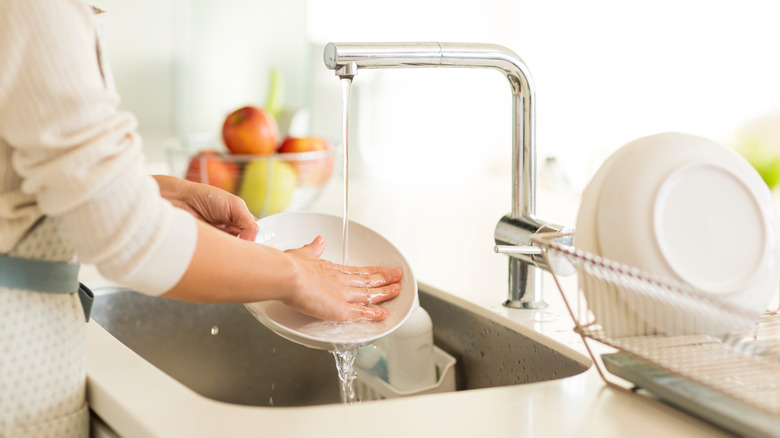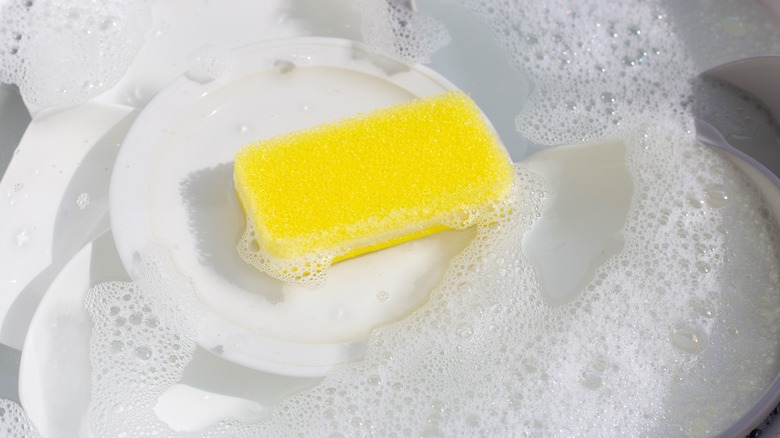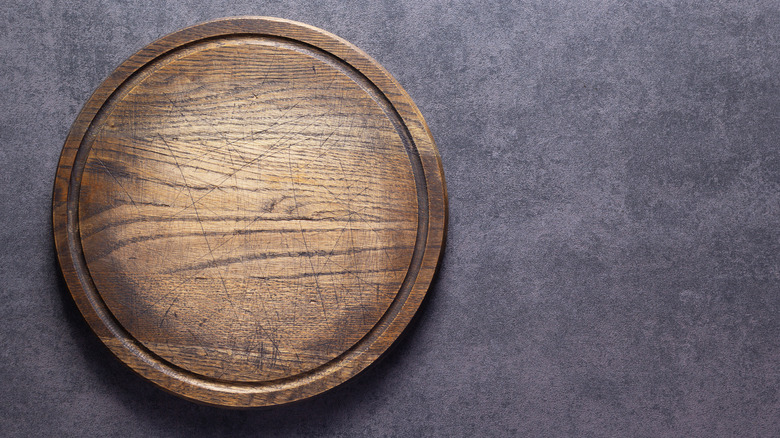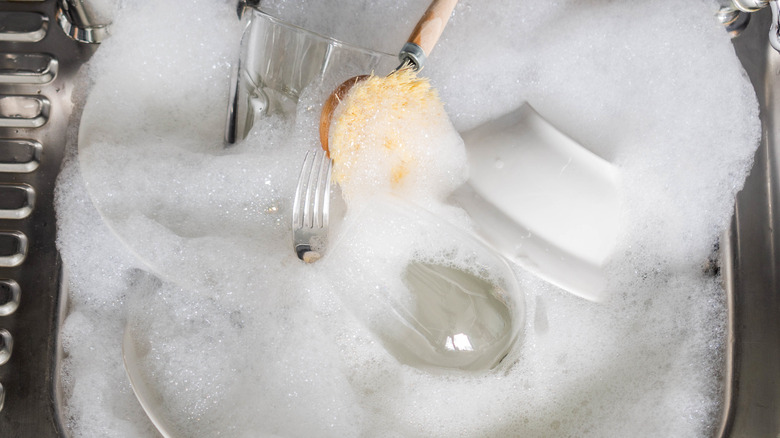5 Mistakes To Avoid When Hand-Washing Your Dishes
Washing dishes is a household chore we do on a daily basis (whether we like it or not). Thankfully, modern dishwashers were invented, which means less work for you and more time for ... well, whatever you want! However, if you don't have a dishwasher in your home, you're stuck with washing dishes the old-fashioned way: by hand. Believe it or not, though, washing your dishes in the sink is more beneficial than you may think. According to Pental, if you're washing fragile dishes, for example, there's less of a chance of them breaking in the sink versus the dishwasher.
Additionally, hand-washing dishes can actually save water, per Brightly, if your dishwasher is older and not as efficient, or if you tend not to load your dishwasher to its full capacity. With that said, you're only saving water by washing your dishes by hand if you make sure to plug up your sink. If you're constantly turning your sink's faucet off and on, in the end, you're really not saving much water. Unfortunately, this is only one of many common errors homeowners often make when washing dishes by hand. Here are another five mistakes you should avoid when hand-washing your dishes.
1. Using a dirty sponge
Washing a dirty dish with a dirty sponge is like using mud to wash yourself in the shower — it doesn't make any sense, nor does anything get cleaned. According to a 2017 study published in Scientific Reports, sponges can potentially contain 362 types of bacteria, which is way more than the amount found in your bathroom. This means you could be spreading hundreds of bacteria all over your dishes. Thankfully, it isn't harmful (but it is super gross). To prevent yourself from even allowing bacteria to form, you should throw away your dish sponge once every week or every two weeks.
Many think you should wait until your sponge starts to smell, but you should actually be tossing it long before it gets to that point. If you don't want to keep buying new sponges every two weeks, microwave yours to get rid of that bacteria. You can also boil them, or let them soak in a watered-down bleach bath.
2. Washing with your bare hands
Wearing rubber gloves to hand-wash dirty dishes isn't just a fad from the 1950s; it's a very practical method that has particular benefits, especially for your hands. Essentially, hot water strips the oils from your skin, causing them to dry out, per the "Today" show. By wearing rubber gloves, you preserve those necessary oils, and help prevent your skin from cracking. If you're a person that loves a good manicure, wearing gloves to wash your dishes also keeps those beautiful nails intact, as dish soap contains chemicals that can take the polish clean off.
If you really need convincing, think about the skin irritations you're subjecting yourself to by not wearing gloves. In fact, you can actually get burns from certain detergent chemcials, according to CNET. Lastly, you're protecting yourself from the disgusting bacteria we mentioned earlier. You wouldn't clean your toilet with your bare hands, would you? The same principle applies to your dishes. You might feel dorky, but by wearing gloves when washing dishes, your hands will thank you.
3. Not soaking your dishes
Another critical mistake you should avoid when hand-washing dishes is not soaking your dishes. If you have dishes that are particularly grimy or have stubborn food remnants that refuse to come off, it's a good idea to go ahead and give them a soak. You can either plug up the sink or use a tub, but you must add hot water to ensure the dishes are getting a thorough soak. By adding just a dollop of dish soap to your hot water, you're helping to lift up and off the crud, grease, and fat glued to the surface, according to The Washington Post.
If you're dealing with a pot or pan with burnt food particles and have tried to soak them the normal way, the next best method is to add baking soda to the soaking water. When hot water and baking soda combine, it causes a fizzing reaction that releases carbon dioxide, which ultimately weakens the remnants and lifts them from the dish.
4. Soaking the wrong dishes
It should be noted not all dishes can be soaked. For example, you would never soak any wooden cookware, cutting boards, or utensils. Doing so can cause a free-for-all for bacteria, according to The Washington Post. Not only that, but soaking a wooden cutting board is the fastest way to ruin it. The soaking process can warp or crack the board, so you should avoid it at all costs, says Mahogany House Woodworks. When washing cookware or other food utensils, all you need is soap, water, and a soft bristle brush to gently wash the food particles away.
Additionally, you should never, under any circumstances, soak a cast-iron pan or other cast-iron cookware. This increases the chances of it rusting. Instead, simply wash it with warm water and mild soap, but keep in mind it won't immediately get rid of all of the stuck food particles. You'll want to use a scrubber specifically made for cast-iron items so you don't scratch the metal.
5. Using way too much soap
More isn't always merrier, especially when it comes to dish soap. One mistake people commonly make when hand-washing dishes is to assume that using a ton of dish detergent will give you a better clean, when, in fact, you're essentially flushing money down the sink drain. People will often add more soap as the suds go away, but it isn't necessary, according to Pril; the chemicals needed to clean the dishes are still in the water, no matter how sudsy the water may be. The next time this happens, save yourself some money and skip the extra bubbles.
Per Wirecutter, a good rule to follow is to start with 1 teaspoon of dish soap for a sink full of dishes and dishwater. Once the water turns dirty, then you can start the process again, with a sink full of clean water and 1 teaspoon of soap — and no more.
